Deep Creek Lake is the biggest artificial freshwater lake in Garett County, Maryland . It’s home to various freshwater fish species and attracts anglers from within and without the state.
Fishing is not the only reason people visit Deep Creek Lake; the expansive coastline, the calm, clear waters, the lush forest surrounding the lake, the wildlife within the surrounding environs, and other fantastic scenery make Deep Creek Lake a dream destination. Read on to discover more about this lake.
History of the Lake
In the early 1900s, the area where Deep Creek Lake currently is was occupied by private residences, schools, farms, and other infrastructure. The turning point for this area came with the idea of bringing electricity and power. In 1921, the Youghiogheny Hydroelectric Corporation got the contract to bring electricity to this area.
However, the actual construction began on November 1, 1923. The project started with the corporation buying the real estate on which the lake currently sits. The real estate transactions cost around $55. Youghiogheny Hydroelectric Corporation then laid out surveys for four Deep Creek Dams and three powerhouses.
Upon buying the real estate and the equipment needed, Youghiogheny Hydroelectric Corporation tasked roughly 100 men with constructing the dams. The project’s completion took around two and a half years. The official opening of the power plant was in May 1925.
The State of Maryland owns Deep Creek Lake. It manages the lake through the Department of Natural Resources, Maryland Park Service.
Size and Depth
Deep Creek Lake is the most expansive inland water body in Maryland. It covers about 3900 acres and is 13 miles long with 65 miles of shoreline. Deep Creek Lake is also one of the deepest lakes in Maryland. Its average depth is 26 feet, while its maximum depth is 75. The lake’s varying depth supports various fish habitats, from silt-bottomed coves at its shallow ends to the steep rocky shorelines near the dam breast.
Deep Creek Lake is also home to the Deep Creek Lake State Park, which features beaches, picnic areas, covered pavilions, biking trails, and more.

Take in the beauty of Deep Creek Lake, Maryland’s most expansive inland water body
©Infinitum Imagery/Shutterstock.com
Access Restrictions
As mentioned earlier, Deep Creek Lake is managed by the Maryland Department of Natural Resources. It is this body that grants boating and fishing access.
Generally, fishing is permitted once you are inside the buffer strip. However, to access the public shoreline, anglers can either use a public access point or obtain written permission from a landowner to cross their land.
Boat fishermen can access the entire lake except for a small area at the lake’s outlet structure. The boat launch at the Deep Creek Lake State Park is the primary access point for boaters—boaters pay a launch fee to use the facility. Boats aren’t permitted to beach at the facility except in emergencies.
Fishing at Deep Creek Lake
Anyone looking to fish in Deep Creek Lake should consult the local resources before heading to the waters. For one, they can point to the best fishing spots, But more importantly, consulting with the authorities will ensure that you don’t break any fishing regulations.
One vital regulation anglers shouldn’t forget is the fishing license requirement to fish in the lake. Anglers can obtain a fishing license from the Maryland Department of Natural Resources (DNR). Alternatively, they can get them from one of the local vendors. Anglers should also check with DNR to determine the fish species in season, the creel limit, and which ones are catch-and-release only.
Remember, any violation of DNR’s fishing regulations could result in hefty fines. You may also get a suspension from fishing in the lake.
That said, here are a few facts and tips for fishing in Deep Creek Lake:
- The best times to fish are early in the morning and late in the evening.
- Anglers can buy artificial and live baits locally.
- Popular artificial baits include spinnerbaits, topwater lures, and jigs.
- Popular live baits include crawfish, shiners, and nightcrawlers.
- Prepare for all weather conditions by carrying essential items like comfortable shoes, extra clothing, and rain gear.
- Carry snacks, water, and a few beers (if you drink), especially if you’re going fishing for a long duration.
Popular Fish in Deep Creek Lake
Deep Creek Lake is considered one of the best fishing lakes in Maryland, and it’s not hard to see why. This sizeable lake provides anglers with a vast area to fish. Additionally, several different species of fish live in this lake. So whether you’re hoping to catch the beautiful rainbow trout or big largemouth bass, this lake has it all. You can also enjoy ice fishing in Deep Creek Lake during the winter.
Let us look at the popular fish you can catch in this lake:
1. Largemouth Bass
Fishing Regulations:
- Minimum size limit: 12 inches or as mandated by special regulations
- Season: Between March 1 and June 15
- Creel limit: 5
- Catch and release fishing is permitted at all times
The largemouth bass is one of the most popular fish species in Deep Creek Lake. This freshwater fish is part of the sunfish family. The largemouth bass has some similarities with other members of the black bass family.
Even so, it has some features that are unique to it. For instance, they are bigger than other bass fish species. Also, their mouths usually extend beyond the rear edge of their eyes, hence their name. The largemouth bass is greenish-gray to olive-gray..
Deep Creek Lake is one of Maryland’s best fishing spots for largemouth bass. And while these fish may not be as abundant as the smallmouth bass, their population in the lake is dominated by quality size fish.
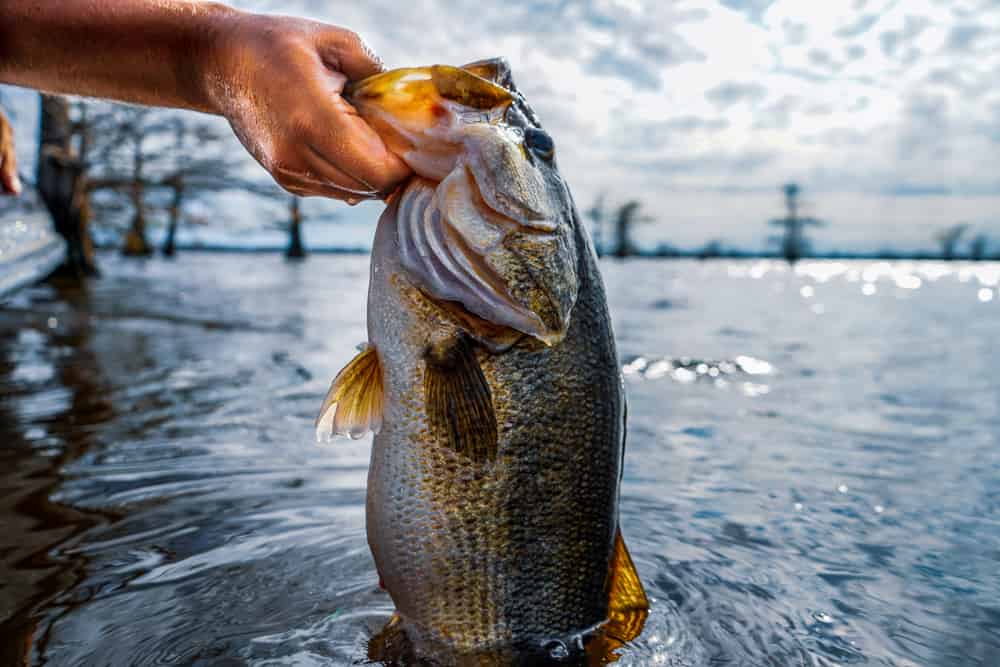
This largemouth Bass is ready to be your next catch of the day.
©Maclane Parker/Shutterstock.com
2. Smallmouth Bass
Fishing regulations:
- Minimum size: 12 inches or as mandated by special regulations
- Season: Closed between March 1 and June 15
- Creel limit: An aggregate of 10
- Catch and release fishing is permitted at all times
Smallmouth bass is another freshwater fish that thrives in the waters of Deep Creek Lake. Like other members of the bass family, the smallmouth bass also belongs to the Sunfish family.
Smallmouth bass prefers tropical and temperate regions. These fish can grow up to 27 inches long and weigh 12 pounds. This fish species usually have varying colors depending on age, water quality, diet, habitat, and spawning cycle.
Smallmouth bass is arguably the most abundant bass in Deep Creek Lake. But this doesn’t mean that catching them is easy. These fish are excellent swimmers and are also relatively aggressive. You’ll need a sturdy fishing line and good bait to catch smallmouth bass.
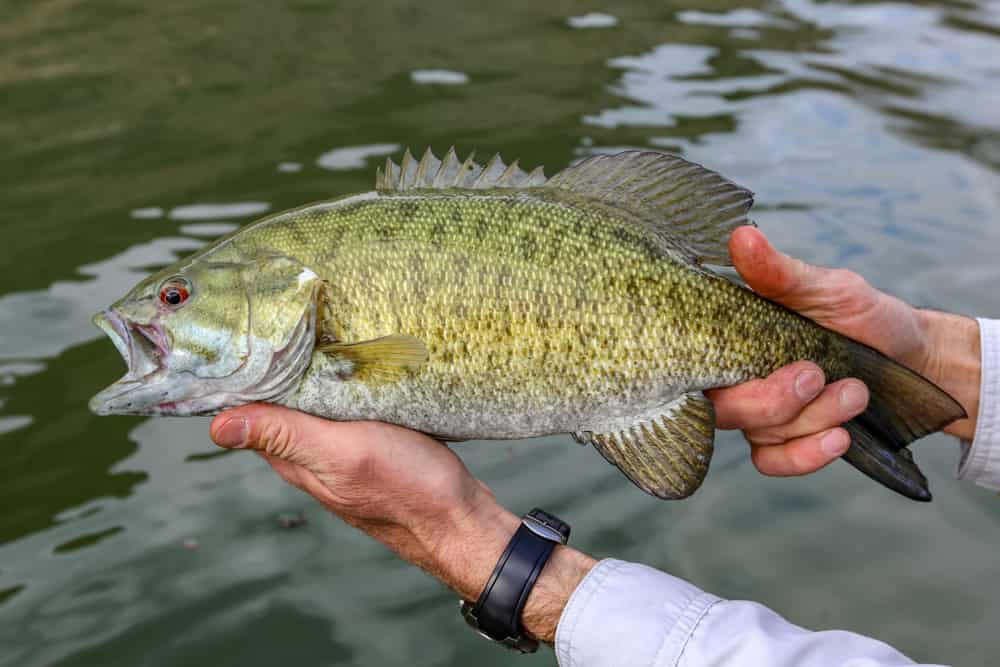
Catch and release – that’s the way to go with smallmouth bass.
©CSNafzger/Shutterstock.com
3. Crappie
Fishing Regulations:
- Minimum size limit: None
- Season: All year round
- Creel limit: Daily around 15 and possession around 30
The Crappie Fish is a medium-sized freshwater fish. This fish is native to North America, though you can find it in other regions today. Crappies usually grow as long as 30 centimeters and weigh up to 4 pounds. They have an oval-shaped body, spiny fins, a downturned mouth, and silvery-green scales.
Deep Creek Lake is considered one of the best crappie fishing lakes in the country, mainly because of the vegetation along its shorelines. To increase your chances of catching crappies, focus your fishing on the drop-off along the lake’s shorelines—crappie fish like hiding under fallen trees, vegetation, or rocks.
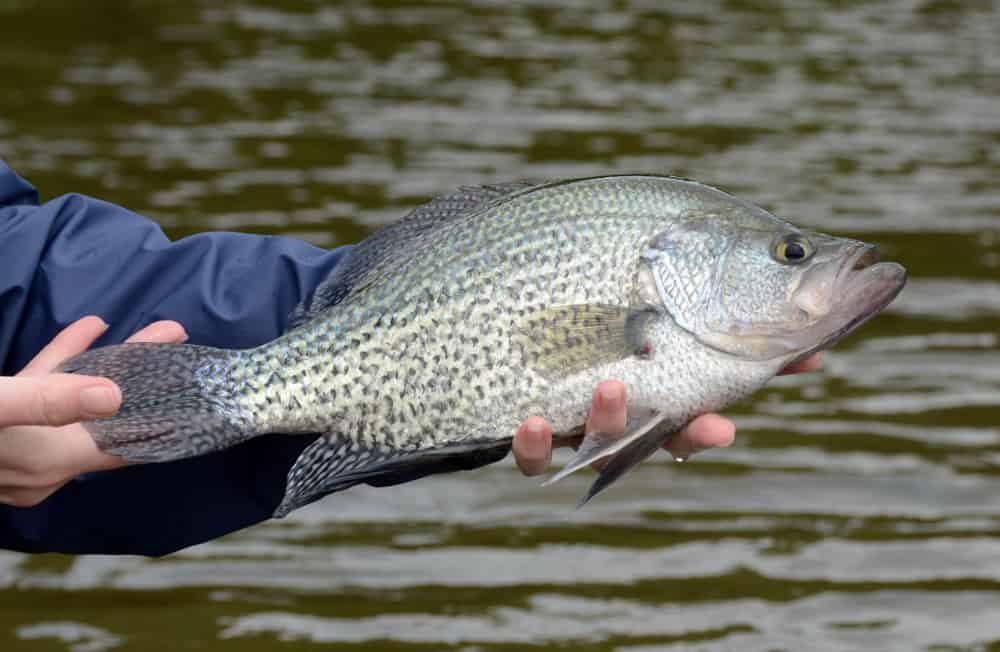
Crappie fish – the perfect catch for a fishing trip.
©M Huston/Shutterstock.com
4. Northern Pike
Fishing Regulations:
- Minimum size limit: 30 inches
- Season: All year round
- Creel: Daily catch 2, possession 4
Northern Pike, or simply pike, often thrive in freshwater. They’re piscivores, meaning they eat other fish. They typically have an elongated head and body and a flat snout resembling a duck bill. The roof of their mouth and jaws have sharp teeth that they use to tear their prey. Unlike most fish, pikes have fins loaded toward their back end.
Northern pikes vary in color depending on where they live. Pikes in dark waters tend to be dark green, while those in clear waters are usually light green. Male and female pikes look alike, but the females tend to be bigger.
Pikes are common in Deep Creek Lake and usually offer anglers a unique trophy fishing opportunity with fish as long as 40 inches regularly caught in this lake.
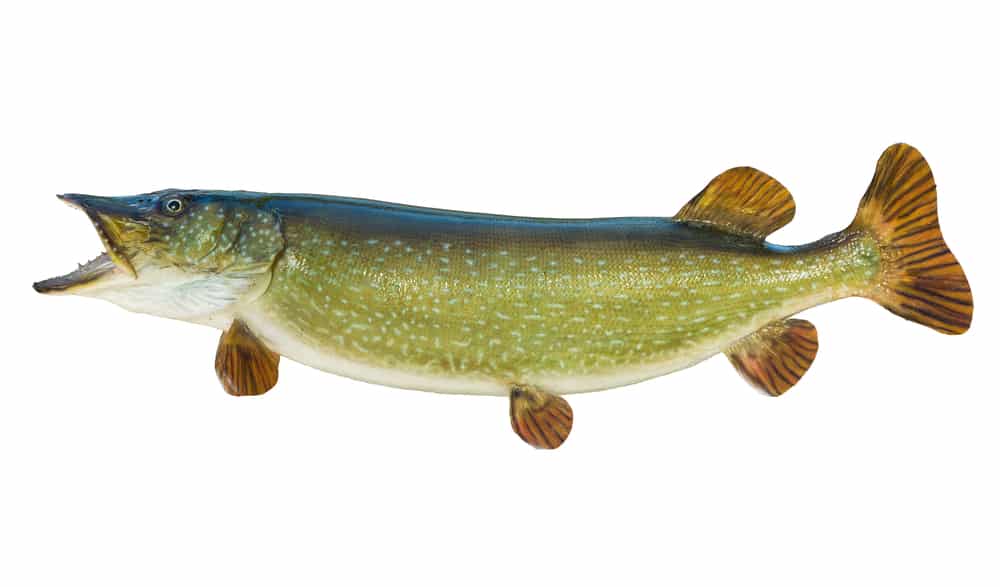
Northern Pike: The undisputed top predator of Northern lakes.
©Dan Thornberg/Shutterstock.com
5. Rainbow Trout
Fishing Regulations:
- Minimum size limit: None
- Season: All year round
- Creel limit: 2 daily and an aggregate of 4 in possession
- Different rules apply to put-and-take regions and special trout management regions
Also known as redband trout, the rainbow trout is a gorgeous fish with patterns and coloring that vary depending on their age, spawning condition, and habitat. Rainbow trout are predominantly yellow-green or blue-green and have a white underbelly, a pink streak on their side, and small black lines on their fins and back. They are also generally torpedo-shaped.
Rainbow trout are considerably sizeable—they’re 20-30 inches long and average 20 pounds. However, they can grow as long as four feet and weigh 53 pounds.
About 4350 brown trout and rainbow trout are stocked in Deep Creek Lake every year. As such, you are likely to catch rainbow trout in the lake.

No matter the time of day, Rainbow Trout are a sight for sore eyes.
©Henrik A. Jonsson/Shutterstock.com
6. Bluegill
Fishing Regulations:
- Minimum size limit: None
- Season: Open all year round
- Creel limit: An aggregate of 15 in a day, and you can possess a total of 30
Like the crappie fish, bluegills are called panfish, given their body size and shape perfectly fit a pan. They are freshwater likes often found in ponds, streams, rivers, and lakes.
Bluegills have thick bodies with small mouths. The scales of these fish can be brown, black, blue, orange, olive-green, or a combination of these colors. Their dorsal fins usually have dark strips and spots at their end.
Bluegills weigh between 1 and 2.5 pounds and average 8 inches in length. The current record for the longest bluegill stands at 16 inches.
The best time to catch bluegill in the Deep is after the spawning season. In summer, you can find these fish around bush piles, edges of weed beds, and flooded timber, more so if there’s deeper water nearby.

It may not be the biggest fish in the sea, but a bluegill is sure an exciting catch.
©Stacey Ann Alberts/Shutterstock.com
7. Brown Trout
Fishing Regulations
- Minimum size restrictions: None
- Season: All year round
- Creel limit: 2 daily and an aggregate of 4 in possession
- Different rules apply to put-and-take regions and special trout management regions
The brown trout is a popular game fish of the Salmonid species found in different types of waters. Their habitat includes freshwater lakes, rivers, streams, and ponds. Some can even live in oceans.
Brown trout got their name from their yellow-orange-olive-brown sides. These fish are usually sizeable. A fully grown brown trout can weigh about 20 pounds, though anglers have caught brown trout weighing more than 20 pounds.
That said, Deep Creek Lake is one of the best places for anglers to catch fish brown trout. For one, there’s an abundance of this fish species in this lake. Moreover, you can fish for them all year round.
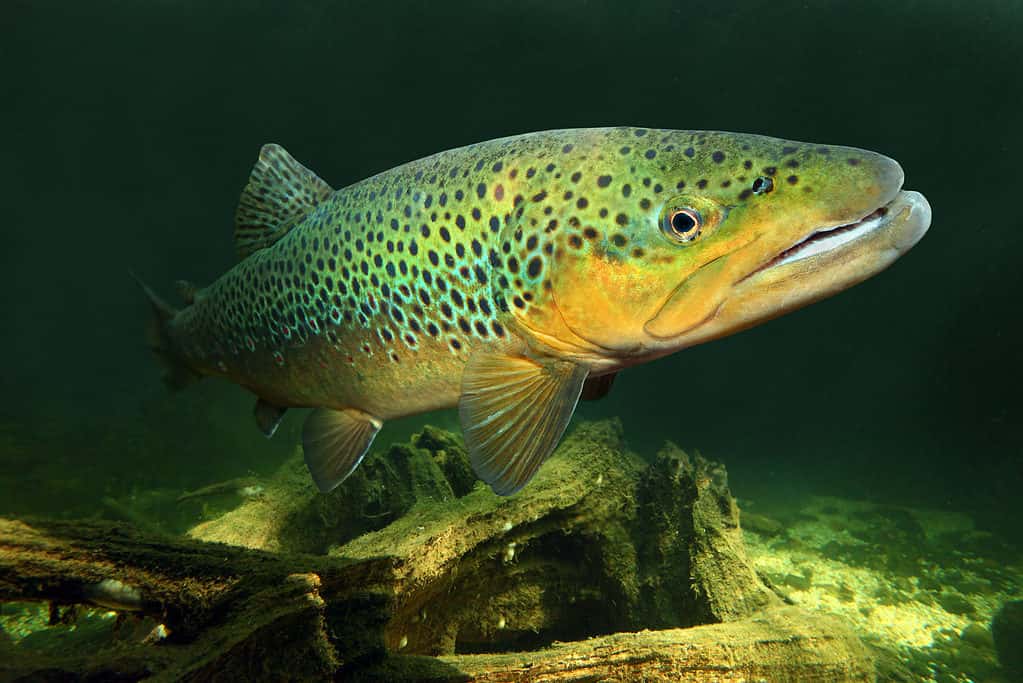
Brown trout are some of the most popular freshwater fish to catch! They can be found in creeks all over North America.
©iStock.com/abadonian
8. Walleye
Fishing Regulations:
- Minimum size limit: 15 inches all year round
- Season: Closed from March 1 through June 15
- Creel limit: 5 daily. You can possess up to 10
Walleye is a popular freshwater gamefish that belongs to the perch family. These fish have long cylindrical bodies and are primarily gold and olive in color with a white belly. The back of these fish is crossed with around five black bands, giving them a unique appearance.
On average, Walleyes weigh about 20 pounds and can grow up to 3 feet long. So if you hope to catch a Walleye, your fishing equipment should be in good condition.

Anglers love walleye for their feisty fight and delicious taste. They make for a great catch – and even better dinner.
©FedBul/Shutterstock.com
Recreation Options
Deep Creek is always a fun place, especially in the summer. You can swim into the lake’s waters to cool your body or enjoy the rush of zipping through the water on your wakeboard. Alternatively, you can rent a boat from the several marinas on the lake and use it to explore its surroundings. Suppose you are more of a kayaker or a stand-up border; there’s also an excellent place to enjoy your favorite activity—you can move to the lake’s southern end, famous for its sailing clubs.
For fishing enthusiasts and anglers, the lake offers calm waters ideal for fishing throughout the year. You can find the fish outlined above and more. If you are lucky, you may make a record-breaking catch of some of the big fish in this lake.
The lake doesn’t close in the winter. Instead, it offers an entirely different type of fun. During this period, anglers can set up tents across the lake in preparation for ice fishing. However, you should pick up your fishing license to avoid fishing regulation non-compliance penalties.
If you want to enjoy non-water activities during your visit to the lake, the trails in the park are great for hiking and bike riding. Similarly, if you want to relax as you enjoy the lake’s breeze, the sandy beach in the state park is great for lying down as you busk in the sun.
What are you waiting for? Travel to Deep Creek Lake to enjoy all the lake has to offer.
The photo featured at the top of this post is © iStock.com/abadonian
Thank you for reading! Have some feedback for us? Contact the AZ Animals editorial team.






